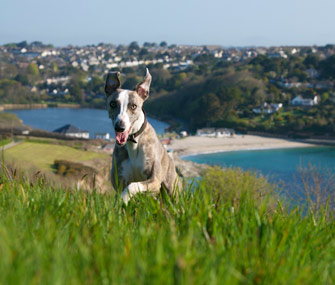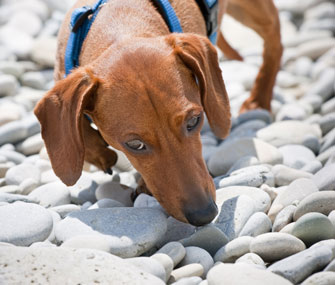Tips for Training Scent and Sight Hounds
Published on August 21, 2013

There are two distinct subgroups within the hound group: the scent hound and the sight hound (although some dogs exhibit both tendencies). As a group, hounds have an elevated desire to pursue prey, but scent hounds and sight hounds vary in significant ways and each presents distinct training challenges.
Scent Hounds vs. Sight Hounds
A scent hound primarily tracks prey by using his nose. The scent hound is built for endurance rather than for short bursts of speed; he can track using scent even when his prey is out of sight. Certain scent hounds will exhibit deep, booming vocalizations. Scent hounds will often tree or corner prey, and use their big voices to alert a handler to the animal’s whereabouts. Many scent hounds have independent personalities, the result of an inborn tendency to be self-sufficient when working at a distance from their handler.
Scent hounds present some common training challenges. The scent hound is easily distracted, especially by smells, which can make outdoor training difficult. A scent hound will often pull on the leash, often because he is on the trail of a particular smell. Some scent hounds are very vocal and may bark and bay for long periods of time, which can cause problems with the neighbors. Scent hounds are also notorious for running after scents and covering great distances without stopping, which makes it almost impossible to let them off leash without extensive training.
Sight hounds, on the other hand, chase prey primarily using vision rather than scent. Even slight changes in the environment are perceived by sight hounds, and anything moving away from them is likely to be seen as potential prey. Sight hounds are built for short-distance, high-speed chases. They work independently and can strike down and kill prey on their own. Some sight hound breeds are considered aloof, catlike and wary of strangers.
Sight hounds are often guilty of running away, chasing after animals and not coming when called (although these are also common scent hound complaints). Sight hounds are extremely quick; the Whippet is the fastest moving domesticated animal of its size, reaching speeds of up to 35 miles per hour. Sight hounds present a high risk of predatory behavior toward small animals, which makes them a potential risk to pets such as rabbits and cats, as well as to any wildlife living near the dog’s home.
Although it can be helpful to know the traits common to the hound group, a variety of factors can affect an individual dog’s character, including specific breed, socialization history and training experience. For instance, since both categories of hounds are likely to pursue scents and sights, freedom is best given only in a fenced area, on a long line or after extensive training. Within the hound group, however, each individual breed has unique characteristics that play a part in shaping personality. Dachshunds are likely to dig, because they were bred to hunt badgers, while Coonhounds, who were bred to tree raccoons, are more likely to chase small animals up trees. Understanding your particular hound and his particular personality will make management and training easier to implement.

Motivating Your Hound
During training, choose rewards that will motivate your specific dog. For instance, if you have a scent hound who is driven to follow smells and pulls on leash, a successful heel can be rewarded by getting to walk (on a loose leash) after a scent. The desire to follow a scent can also be used to teach come when called: Start your hound off on a shortened portion of long line and call him to you. When he comes in response to the command, reward him with the full freedom of the long line. This will teach him that coming to you results in being allowed to pursue all those interesting smells around him.
Since sight hounds are motivated by pursuit, you can reward your hound for responding to a command with a game of chase. Create a safe game of chase using a stuffed animal on the end of a rope, or a Chase-It or Longshot Toy. Running away from your hound to incite a game of chase can be fun for your dog and also helps reinforce the come-when-called command.
Hounds are often pickier eaters than other dogs, but food can still be used as a motivator. For choosy hounds, it’s important to use treats wisely. Feed your dog structured meals throughout the day and train just before each meal, when he is hungriest. Treats should be kept in pea-sized pieces or smaller. Keep training sessions short — 1 to 5 minutes at the most — to keep your dog focused. Clicker training can be an effective way to teach new behaviors to dogs who are uninterested in following a food lure.
Hounds have high energy and a desire to work. Your hound needs a variety of exercise options, all of which utilize his natural instincts. Lure racing is a popular sport for sight hounds, while scent hounds may enjoy search-and-rescue work. You can also create your own games at home, such as hiding kibble or treats in food puzzles, or grabbing a ball for a round of fetch.
Read more about various hound breeds by going to Vetstreet's dog breed guide or by clicking below:
Afghan Hound, American Foxhound, Azawakh, Basenji, Basset Hound, Beagle, Black and Tan Coonhound, Bloodhound, Bluetick Coonhound, Borzoi, Cirneco dell'Etna, Dachshund, English Foxhound, Greyhound, Harrier, Ibizan Hound, Irish Wolfhound, Norwegian Elkhound, Otterhound, Peruvian Inca Orchid, Petit Basset Griffon Vendeen, Pharaoh Hound, Plott, Portuguese Podengo, Redbone Coonhound, Rhodesian Ridgeback, Saluki, Scottish Deerhound Sloughi, Thai Ridgeback, Whippet





